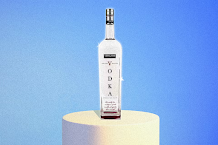The two vodkas on the menu were of the same brand name but had different countries of origin, different makers, different base ingredients—and Abou-Ganim could tell. I hadn’t outright asked him to taste-test them, but I had been hoping he would. He much preferred the French-made vodka to the American-made one, and that’s not just snootiness. He’s a big fan of other American vodkas, like the now-ubiquitous Tito’s. (He knows Tito.)
The French vodka has notes of vanilla and caramel—dare he say, a crème brûlée taste? A nice acidity with notes of lemon, citrus, and white pepper on the back, he told me, evoking an instant “saliva drip.” Although the American didn’t cut it for him, the experts at the New York Times’ Wirecutter full-throatedly endorsed it. According to those taste-testers, it has subtle hints of citrus and rose and the texture is silky.
These careful, artful descriptions surprised me: Discussions of tasting notes, mouthfeel, and terroir are often deserved for fine wines and expensive whiskeys. Certainly not vodka, which, as many a college student has determined, is best when nearly invisible.
Also surprising? The humble point of purchase of these vodkas. To try them yourself, you’ll need to journey past the window selling $1.50 jumbo hot dogs, past the 83-inch 4K-resolution TVs, past the brilliant-cut diamond engagement rings, and past the 36-roll family packs of Scott toilet paper. These are Kirkland Signature vodkas, house spirits of the big-box superstore Costco.
What makes Kirkland’s vodkas so tantalizing is not merely that they’re a grocery store steal—priced between $10 and $25 for a cartoonish 1.75 liters of spirit, with no other size options. It’s that these spirits come with a mixed-in spice of intrigue, mystique, and lore. Connoisseurs (and anyone who puts them to a taste test, really) consider them legitimately good. Kirkland Signature American Vodka was not merely in the Wirecutter review for the best vodka, which was written by Haley Perry, a former bartender. It earned the top spot, a “unanimous favorite.”
Rumors have long abounded that Kirkland vodka is simply a dressed-down version of the most gussied-up mass-market vodka: Grey Goose. This isn’t the case, but the rumor itself, which has been swirling for nearly two decades—at least—leads us to a better understanding of a world in which the two could plausibly be confused. Because we live in that world. As the Kirkland saga exemplifies, vodka is both firmly lodged in American consumption and woefully misunderstood.
Vodka has been popular in Europe—namely, Poland and Russia and Sweden—for generations and generations. But in the past century, it has had a transcendent rise here in the U.S. and, since 1976, has been the bestselling spirit in the country. In 2023 Americans bought $7.2 billion worth of vodka, according to the Distilled Spirits Council of the United States. That’s more than whiskey, cognac, gin, and rum. Tequila and mezcal are on the rise, but they still sit in second place, with $6 billion in sales.
But vodka, for its long history as a commercial juggernaut, has also become something of a punchline in the drinking and bartending communities. Abou-Ganim, who wrote the 2013 book Vodka Distilled, recounted a trip to an Oakland cocktail bar where he was surprised to find its menu completely lacking in vodka-based options. He asked the mustachioed twentysomething bartender whether the establishment carried vodka at all.
“Yes, we carry two,” the bartender said to him. “And in my opinion, that’s two too many.”
There’s an underlying paradox in vodka that might explain its status among the nation’s snootiest imbibers: No one seems quite sure whether it’s supposed to taste like nothing or whether it’s supposed to taste like something.
by Scott Nover, Slate | Read more:
Image: LeMusique/iStock/Getty Images Plus and Costco.